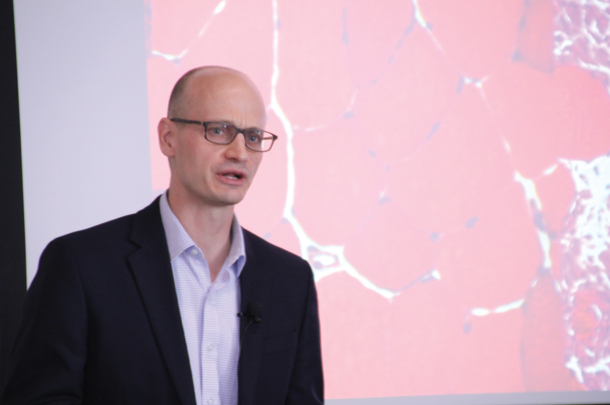Obesity, narcolepsy, leukemia and muscle injuries have at least one thing in common — they are engaging the next generation of top stem cell scientists.
Five of these scientists presented their research March 3 at the Junior Faculty Candidate Mini-Symposium hosted by USC’s Department of Stem Cell Biology and Regenerative Medicine:
Hao Yuan Kueh, PhD, from the California Institute of Technology introduced his research about so-called gene circuits in the immune systems of mammals. These complex networks of genes work together to control whether immune stem cells replicate themselves or differentiate into more specialized cell types: macrophages and T-cells. Using a combination of experimental and mathematical approaches, Kueh has offered a potential strategy for understanding the development of normal immune cells, as well as bettering human health.
Florian Merkle, PhD, from Harvard University described converting stem cells into the brain cells that malfunction in two common diseases: obesity and narcolepsy. He created a technique for safely studying these diseases in the laboratory by producing three types of brain cells: hypocretin (HCRT) neurons that promote wakefulness, agouti-related peptide (AGRP) neurons that promote feeding, and pro-opiomelanocortin (POMC) neurons that inhibit feeding. This research could pave the way for correcting mutations or transplanting replacement neurons into patients with these and other diseases.
Robert A.J. Signer, PhD, from the University of Texas, Southwestern, described an important difference between blood-forming, or hematopoietic, stem cells (HSCs) and partially or fully differentiated blood cells. Individual HSCs synthesize far less protein than their more differentiated counterparts. Subtle changes to this level of protein synthesis can promote or prevent aging and diseases, including leukemia, anemia and bone marrow failure.
Joseph T. Rodgers, PhD, from Stanford University discussed how stem cells repair and regenerate tissue, including muscle, skin and bone. Injury activates nearby stem cells and also puts more distant stem cells on alert, preparing the entire body to help with repair if needed. Rodgers has identified some of the key molecular signals that put these stem cells on alert — including a protein called hepatocyte growth factor (HGF) that could potentially be injected into patients to stimulate wound healing.
Pedro Batista, PhD, from Stanford University began his talk by declaring his passion for messenger RNA (mRNA), which carries genetic information from DNA to the cell’s protein-making machinery. Much of this mRNA has been chemically modified by a molecule called “N6-methly-adenosine (m6A).” Batista has made inroads into the mystery of these modifications by finding that m6A enables stem cells to differentiate into specific cell types, and it prevents tumor formation.
Andy McMahon, PhD, FRS, chair of the Department of Stem Cell Biology and Regenerative Medicine, concluded the day’s activities by offering his enthusiastic thanks to these six leading candidates for junior faculty positions at USC.
“It’s a real treat to have five individuals of the caliber of the five that are visiting,” he said. “It was an excellent series of very diverse talks.”
— Cristy Lytal


